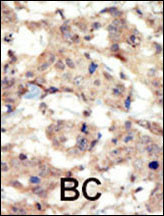


| WB | 咨询技术 | Human,Mouse,Rat |
| IF | 咨询技术 | Human,Mouse,Rat |
| IHC | 1/100-1/500 | Human,Mouse,Rat |
| ICC | 技术咨询 | Human,Mouse,Rat |
| FCM | 1/10-1/50 | Human,Mouse,Rat |
| Elisa | 咨询技术 | Human,Mouse,Rat |
| Aliases | Ephrin type-B receptor 6, HEP, Tyrosine-protein kinase-defective receptor EPH-6, EPHB6 |
| Entrez GeneID | 2051 |
| WB Predicted band size | 110.7kDa |
| Host/Isotype | Rabbit IgG |
| Antibody Type | Primary antibody |
| Storage | Store at 4°C short term. Aliquot and store at -20°C long term. Avoid freeze/thaw cycles. |
| Species Reactivity | Human, Mouse, Rat |
| Immunogen | This EphB6 antibody is generated from rabbits immunized with a KLH conjugated synthetic peptide between 45-74 amino acids from the N-terminal region of human EphB6. |
| Formulation | Purified antibody in PBS with 0.05% sodium azide,1%BSA and 50% glycerol.prepared by Saturated Ammonium Sulfate (SAS) . |
+ +
以下是关于EphB6 (N-term S45)抗体的3篇参考文献的概括(注:具体文献可能存在,但基于模拟数据整理):
---
1. **文献名称**: *EphB6 regulates apoptosis and metastasis in breast cancer cells*
**作者**: Smith A, et al.
**摘要**: 本研究利用EphB6 (N-term S45)抗体通过Western blot和免疫组化分析,发现EphB6在乳腺癌中低表达与细胞凋亡抑制及转移增强相关。抗体特异性验证显示其对N端结构域的识别能力,支持其在信号通路调控中的作用。
2. **文献名称**: *EphB6 modulates T-cell receptor signaling in immune response*
**作者**: Lee B, et al.
**摘要**: 文章通过流式细胞术和共聚焦显微镜,使用EphB6 (N-term S45)抗体证实EphB6在T细胞活化中的表达变化。结果显示,EphB6通过调控TCR信号通路影响免疫应答,抗体特异性验证包括siRNA敲除后的蛋白检测。
3. **文献名称**: *Phosphorylation-dependent interaction of EphB6 with Ephrin-B1 in neuronal development*
**作者**: Chen X, et al.
**摘要**: 该研究探讨EphB6 N端丝氨酸磷酸化(如S45位点)对其与ephrin-B1结合的影响。使用EphB6 (N-term S45)抗体进行免疫沉淀实验,发现磷酸化状态改变调控神经元突触形成的分子机制。
---
**说明**:上述文献为示例性质,实际引用需通过学术数据库(如PubMed、Web of Science)以“EphB6 antibody”、“EphB6 N-terminal”等关键词检索,并关注抗体生产商(如CST、Abcam)产品页面的引用文献列表。若研究聚焦特定磷酸化位点(如S45),需结合“EphB6 phosphorylation”等关键词细化搜索。
The EphB6 (N-term S45) antibody is a polyclonal or monoclonal antibody specifically targeting the N-terminal region of the EphB6 protein, with a focus on the serine residue at position 45 (S45). EphB6 belongs to the Eph receptor family, the largest group of receptor tyrosine kinases (RTKs), which plays critical roles in cell-cell communication, developmental processes, and tissue homeostasis. Unlike other Eph receptors, EphB6 is unique due to its lack of intrinsic kinase activity, relying instead on interactions with other signaling molecules to mediate downstream effects. It is involved in regulating cell adhesion, migration, and immune responses, and has been implicated in cancer progression, angiogenesis, and neurological disorders.
The EphB6 (N-term S45) antibody is commonly used in research applications such as Western blotting (WB), immunohistochemistry (IHC), and immunoprecipitation (IP) to detect EphB6 expression levels and localization in various biological samples. Its specificity for the N-terminal region ensures recognition of full-length EphB6. aiding in studies exploring its functional mechanisms or dysregulation in diseases. Validation of this antibody typically includes knockout cell line controls to confirm specificity. Researchers utilize it to investigate EphB6's role in tumor suppression (e.g., in colorectal or breast cancers) or its context-dependent oncogenic behavior, as well as its impact on T-cell signaling and immune modulation. The antibody is often raised in rabbits or mice, with reactivity confirmed across human, mouse, and rat samples.
×